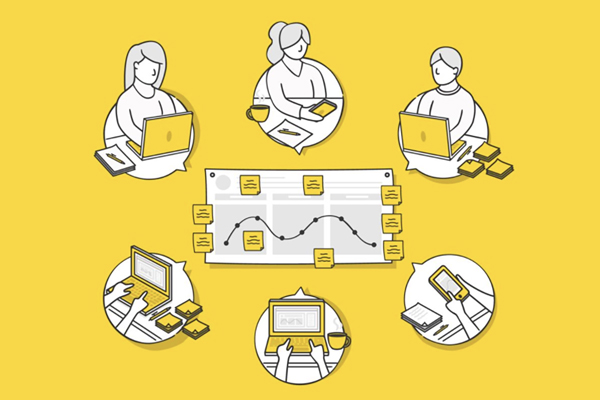What Does Innovating at a Social Distance Look Like? Three Practical Tips.
It’s official. Social distancing, virus curve-flattening, or not, the working world is increasingly exploring its options for virtual meetings, collaborating, and workshopping. We’re off-site increasingly more every year (and it’s not stopping anytime soon). We live in Zoom now. And we’re even hosting virtual networking events, digital lunches, and even enjoying concerts online.
But what if your work or research is built around face-to-face collaboration? How do you translate all the in-person activities you’d typically do during a workshop or brainstorming session onto individual screens, collect feedback, and keep the conversation (and ideas) flowing at a social distance?
At THRIVE, we’re experts at this already, much of our work has evolved to accommodate for social distance based constraints. From accounting for low-immunity, elderly and aging patient types when working with medical clients to dealing with challenging geography, time zone and travel time considerations, and tight C-suite scheduling. Working at a social distance is becoming more the norm than the exception in today’s research.
So, we have a few pieces of wisdom to share around how to keep your innovation efforts on track, so you arrive ahead when the COVID-19 crisis finally passes, or the digital curve becomes mainstream. Virtual workshops are a great way to make this happen. Here are our three best tips for making your upcoming virtual workshop or collaboration session as productive, efficient, and successful as possible:
THRIVE’s “Cs” of working apart, together.
COMMUNICATION
The two biggest concerns about hosting a workshop or any collaborative session virtually at a social distance are “How will I encourage the type of free-flowing collaborative communication I would get if we were all in a room together.” And “I can’t even imagine doing this type of work across one or two locations, let alone with every participant in their individual location.” With participants staring at their solitary screens and facilitators miles away in empty rooms of their own, it’s a fair question. We all know what tends to happen on conference calls: half the group is checked out answering email, someone’s dog is barking, and someone else is watching Netflix (without the chill, of course).
But, it doesn’t have to be that way. First, facilitators must prepare to offer a heightened level of presence and engagement (Mustering all the “extra” you can isn’t for the faint of heart; it’s something we talk about here.) Organize sessions and break-times to keep the momentum up and give people natural moments of rest. But as for the physical aspect of communicating, there’s a bunch of tools to help keep the conversation flowing.
The one we like best is Zoom. It’s not the only option, but it’s the best fit for what we do and how we work. Zoom is dead simple, has an easy-to-use interface, and some sophisticated features that aren’t as convoluted to use as some of its competitors. The best perk we’ve found for collaborative workshops is Zoom’s breakout room feature. Facilitators can host a large group “Zoom Room” but also designate connected “breakout” side-rooms for collaborative work in small groups. A secondary facilitator can join each one; attendees can be herded there automatically by job title or designation, or go voluntarily. The leading room facilitator can also broadcast messages to all rooms, somewhat like your old high school’s PA system, just in a less-obtrusive text format. Handy when there’s say, five minutes left to wrap a breakout session and convene back in the main room to collect insight or ideas.
COLLABORATION
If you could be together in a physical space, the table would be littered with Post-it Notes, and the Sharpie ink would be free-flowing. Everyone would be out of their seats, bouncing ideas off one another, writing on the board, and posting their meatiest thoughts like they’re going out of style. (Well, as a facilitator, you dream about this kind of interaction. Your results may vary, but it’s the goal, right?) But at a social distance with everyone sequestered at their screen, however, it’s a little harder to imagine facilitating rousing collaboration. Fortunately, there are some great tools for that, too.
We use Mural, a robust digital workspace for visual collaboration that works like a juiced-up whiteboard with an “everybody in the pool” mentality. Send out a link to the whiteboard to your zoom room participants, and you’re off to the races. It’s not a difficult tool to use. Still, one thing we like to do to get the creative juices flowing (and head off technical difficulties) is to make the first exercise a Mural-facilitated icebreaker that also works to onboard people into the interface. One easy game we’ve developed asks participants to find their name on a randomized seating chart of sorts, drag it to a more organized board to claim their space. We then play “Three Animals” (participants list the first three animals that come to mind, and later it’s revealed that the first one is how you see yourself; second, how others see you; third, how you really are). The point is you have to put people into the tool’s workspace and let them play around a bit before beginning the real exercise.
There’s an exciting side-benefit to using online whiteboard software to collaborate as well. We find that the “facelessness” of the activity levels the playing field for less confident participants. In-person, during collaboration, influential personalities, and people in places of power tend to dominate the conversation. Online, we’re distanced a bit, and we find we are also emboldened. We all know that’s true on social networks (in a negative way), but here, workshop leaders get a nice benefit from it: people who might be less likely to speak up in-person tend to contribute more virtually rather than ceding ground to more assertive team members.
COORDINATION
The most significant piece of social distance advice we can give anyone attempting an entirely virtual collaborative workshop is to prepare ahead of time and also use downtime between sessions to consolidate findings and re-prepare for the next meeting.
Before a workshop, we spend time framing the data we’ve received from our clients. Digging into relevant trends, re-mining data from ethnographic work, reviewing technology capabilities, and segmentation studies to develop interactive ideation tools like “how might we” statements and creative springboards that drive action. After day one, we close our laptops, knowing that everything that was said and recorded from the day’s session is inside (no terrible handwriting to decipher or lost sticky-dots to track down) and spend the evening formalizing next steps. In the digital world, your notes are easy to find, and you get a kind of bonus object-permanence from knowing exactly where your best ideas were on the digital board because they’ll never be shuffled into a stack of papers or moved out of view. These things are a few of the surprising benefits of having an all-virtual session.
Oh, another perk: The ability to have a dedicated “organizer” working diligently – and invisibly – behind the scenes to collect, record, and synthesize information on the fly. Since they can be entirely out of view, this aggregator can do their thing without stepping into the frame and derailing momentum. It’s a glorious thing and can give teams a leg up with well-presented findings and insight fresh and hot off the presses on day two or three.
Alright, it’s go time. Fire up the virtual meeting room, let the attendees in from the lobby, and turn on the charm. Your foray into the world of virtual workshops is about to begin. Hopefully, you feel a little more ready now, and a little excited too. It’s a bit of a brave new digital world, but we’re going to meet it together, if physically apart.
Need help planning, creating, or running a virtual research or collaboration project? Let’s talk. Contact THRIVE on discussing how we might help you facilitate digital collaboration today.








